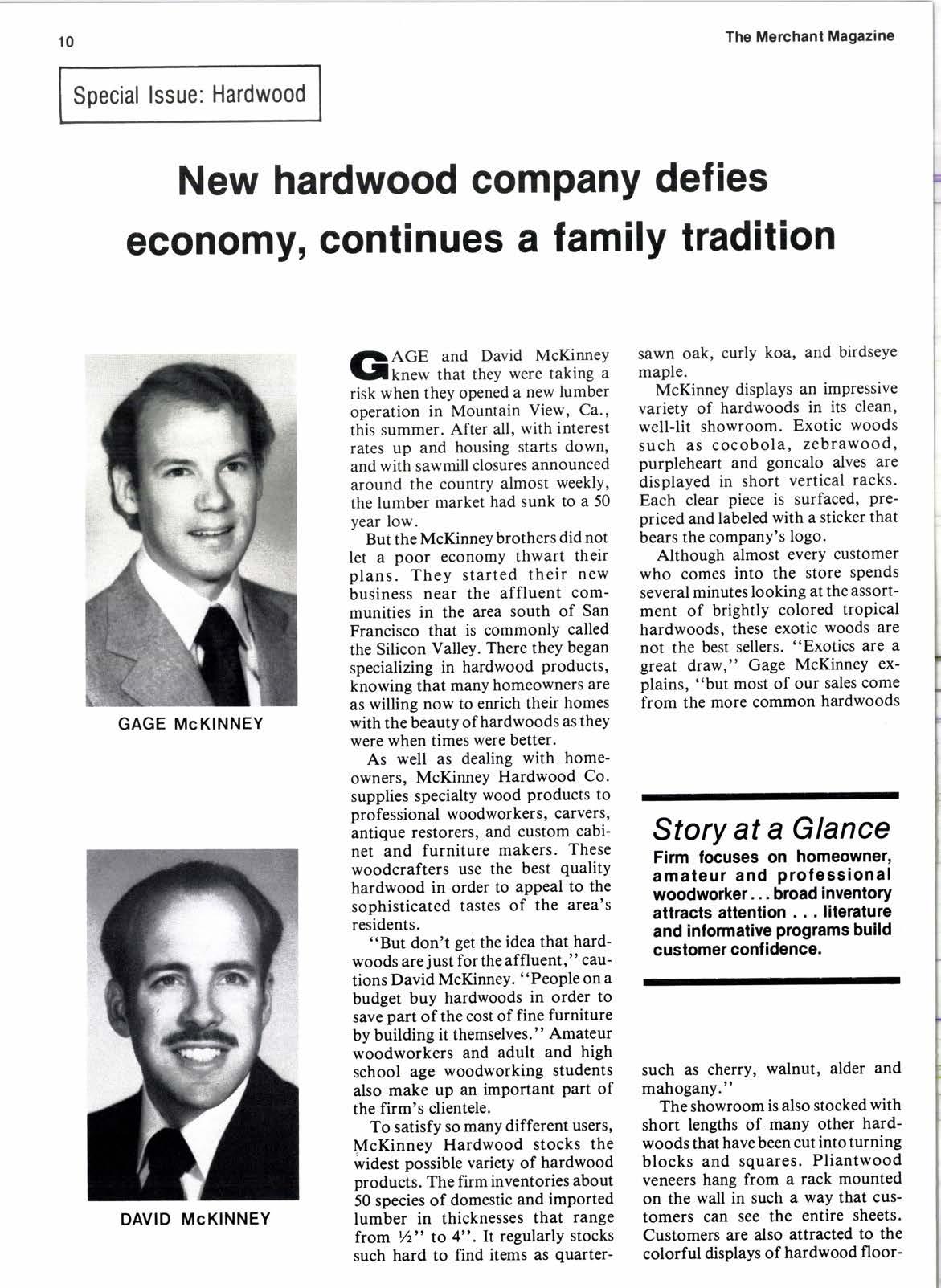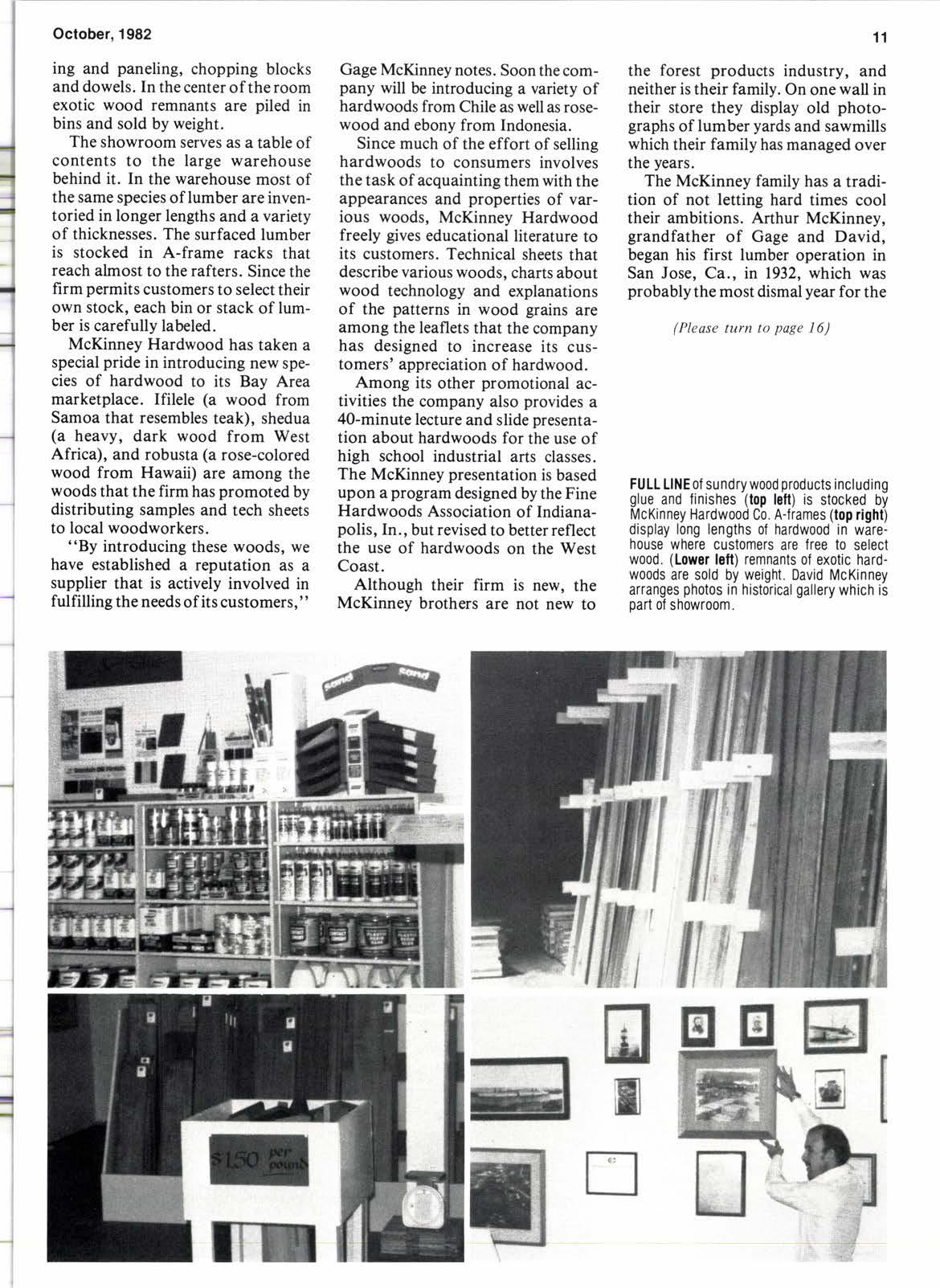
3 minute read
New hardwood company defies econoffiv, continues a family tradition
AGE and David McKinneY knew that they were taking a risk when they opened a new lumber operation in Mountain View, Ca., this summer. After all, with interest rates up and housing starts down, and with sawmill closures announced around the country almost weeklY, the lumber market had sunk to a 50 year low.
But the McKinney brothers did not letapoor economy thwart their plans.They started their new business near the affluent communities in the area south of San Francisco that is commonlY called the Silicon Valley. There they began specializing in hardwood products, knowing that many homeowners are as willing now to enrich their homes with the beauty of hardwoods as they were when times were better.
As well as dealing with homeowners, McKinney Hardwood Co. supplies specialty wood products to professional woodworkers, carvers, antique restorers, and custom cabinet and furniture makers. These woodcrafters use the best qualitY hardwood in order to appeal to the sophisticated tastes of the area's residents.
"But don't get the idea that hardwoods are just for the affluent," cautions David McKinney. "People on a budget buy hardwoods in order to save part of the cost of fine furniture by building it themselves." Amateur woodworkers and adult and high school age woodworking students also make up an imPortant Part of the firm's clientele.
To satisfy so many different users, McKinney Hardwood stocks the widest possible variety of hardwood products. The firm inventories about 50 species of domestic and imported lumber in thicknesses that range from Vz" to 4". It regularly stocks such hard to find iterns as quarter- sawn oak, curly koa, and birdseYe maple.
McKinney displays an imPressive variety of hardwoods in its clean, well-lit showroom. Exotic woods such as cocobola, zebrawood, purpleheart and goncalo alves are displayed in short vertical racks. Each clear piece is surfaced, Prepriced and labeled with a sticker that bears the company's logo.
Although almost every customer who comes into the store spends several minutes looking at the assortment of brightlY colored troPical hardwoods, these exotic woods are not the best sellers. "Exotics are a great draw," Gage McKinneY explains, "but most of our sales come from the more common hardwoods
Story at a Glance
Firm focuses on homeowner, amateur and professional woodworker. .. broad inventory attracts attention . . . literature and infomative programs build customer confidence.
such as cherry, walnut, alder and mahogany."
The showroom is also stocked with short lengths of many other hardwoods that have been cut into turning blocks and squares. Pliantwood veneers hang from a rack mounted on the wall in such a way that customers can see the entire sheets. Customers are also attracted to the colorful displays of hardwood floor- ing and paneling, chopping blocks and dowels. In the center of the room exotic wood remnants are piled in bins and sold by weight.
The showroom serves as a table of contents to the large warehouse behind it. In the warehouse most of the same species of lumber are inventoried in longer lengths and a variety of thicknesses. The surfaced lumber is stocked in A-frame racks that reach almost to the rafters. Since the firm permits customers to select their own stock, each bin or stack of lumber is carefully labeled.
McKinney Hardwood has taken a special pride in introducing new species of hardwood to its Bay Area marketplace. Ifilele (a wood from Samoa that resembles teak), shedua (a heavy, dark wood from West Africa), and robusta (a rose-colored wood from Hawaii) are among the woods that the firm has promoted by distributing samples and tech sheets to local woodworkers.
"By introducing these woods, we have established a reputation as a supplier that is actively involved in fulfilling the needs of its customers, "
Gage McKinney notes. Soon the company will be introducing a variety of hardwoods from Chile as well as rosewood and ebony from Indonesia.
Since much of the effort of selling hardwoods to consumers involves the task of acquainting them with the appearances and properties of various woods, McKinney Hardwood freely gives educational literature to its customers. Technical sheets that describe various woods, charts about wood technology and explanations of the patterns in wood grains are among the leaflets that the company has designed to increase its customers' appreciation of hardwood.

Among its other promotional activities the company also provides a 40-minute lecture and slide presentation about hardwoods for the use of high school industrial arts classes. The McKinney presentation is based upon a program designed by the Fine Hardwoods Association of Indianapolis, In., but revised to better reflect the use of hardwoods on the West Coast.
Although their firm is new, the McKinney brothers are not new to the forest products industry, and neither is their family. On one wall in their store they display old photographs of lumber yards and sawmills which their family has managed over the years.
The McKinney family has a tradition of not letting hard times cool their ambitions. Arthur McKinney, grandfather of Gage and David, began his first lumber operation in San Jose, Ca., in 1932, which was probably the most dismal year for the
(Please turn to page I6)
FULL Ul{E of sundry wood products including glue and linishes (lop lell) is stocked by McKinney Hardwood Co. A-frames (top right) display long lengths of hardwood in warehouse where customers are free to select w00d. (Lowor left) remnants of exotic hardwoods are sold by weight. David McKinney arranges photos in historical gallery which is oart of showroom.










